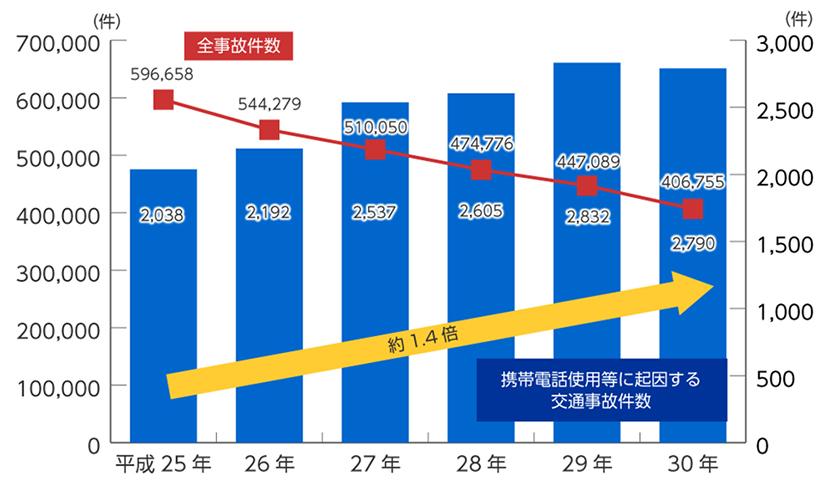Does the visibility "95%" disappear?Verify the dangers of "smartphone" by gaze measurement
Have you ever been wearing a "smartphone while being a smartphone", or you've been about to hit a pedestrian or a telephone pole, or you've stepped out of the stairs?
Now that the use of smartphones has become commonplace, this modern illness is "harmful and no benefit."It is one of the factors that cause life -threatening accidents and troubles, such as traffic accidents, troubles in the station premises, and falling accidents.
We talked to Kazuhiro Kozuka, an emeritus professor at Aichi Institute of Technology, who has studied the dangers of smartphones with a scientific approach such as measuring the gaze of people.
携帯電話使用等に起因する交通事故件数と原付以上運転者の交通事故件数
(Quoted source: Government Public Relations Online)
In 5 years from 2013 (Heisei 200) to 2018 (Heisei 30), the number of traffic accidents caused by smartphones such as smartphones is about 1..It has increased 4 times.The number of accidents is increasing as the number of accidents declines, and smartphones are one of the reasons that can be said to be social problems.
Accidents and troubles caused by smartphones.Your actions may create regrets for a lifetime
プロフィール
Aichi Technical University Kazuhiro Kazuka (Kazuka Kazuhiro) graduated from the Faculty of Engineering, Nagoya University in 1968.He finished his doctoral program in 1973 and joined Toyoda Central Research Institute.Engaged in the combustion research of automotive engines, basic research and development of ETC (automatic fee collection system).In 2002, he arrived at Aichi Technical University Faculty of Engineering.From 2011 to 2014, he served as director of Engineering and Director of Engineering.IEEE International Vehicle Electronics Conference (IVEC) 2001 Best Paper Award, 12th ITS Symposium 2014 Excellent Public Award.He has authored books such as "Detection of driver status, estimated technology, autonomous driving, and driving support system: Inspection: How to measure the behavior of drivers and evaluate the concentration for driving" (Technical Information Association).

Please tell us how you started researching your smartphone gaze measurement.
It was in 2004 that he began to study his gaze movements when using a mobile phone while driving a car.In 2008, the revised Road Traffic Law was enforced, and operations such as mobile phones and earphones during bicycle driving were specified as violation of safe driving duty, so we started research on gaze measurements as well as cars.
When do you feel that the number of smartphone accidents has increased?
It has been around 2011 when smartphones spread rapidly.In the same year, we decided to conduct a demonstration experiment at Seibu Shinjuku Station to disseminate the possibility of an accident on a smartphone while at the station platform.In 2013, an accident occurred at JR Yotsuya Station, when an elementary school student was watching a smartphone and fell on the track.Although he ran away to the depression under the platform, the Chuo Line stopped for hours and it became a big problem.
After that, an accident occurs frequently, such as a person walking on the platform of the station while looking at the smartphone, fell on the track and died on a train.After the demonstration experiment, accidents will be continuous as you foreseeing the bad future.
Please tell us specifically the contents of the experiment at that time.
We had students attach a gaze measurement device and walked around the platform of Seibu Shinjuku Station, which has ordinary customers, while operating a smartphone.The students walked the platform while watching Twitter, but because new information came in one after another, the gaze was concentrated on the smartphone screen.When staring at the screen, there is an experimental result that the visibility is one -tenth.In other words, 95%have lost their horizons.
During the experiment, it seemed that young children and mothers' parents and children overtaken the student, but the students did not notice the child.It is a misunderstanding that you can see it because you are in sight.It can be said that it is only visible to the person who has entered the field of view, the car, etc. and is recognized by the brain.
横断歩道での「ながらスマホ」視線検証
In the case of no tasks (about 18 seconds across), the gaze movement range is wide, especially in the horizontal direction.The surrounding safety can be confirmed enough and can respond to changes in the situation
When making a call (about 21 seconds, 17 % increase), compared to a task without a task, the movement range of the gaze is slightly narrower and the appearance of the surroundings is not recognized.The condition is considered, and it is insufficient for safety confirmation.
When reading and inputting SNS (about 24 seconds, increased by 31 % across), the gaze is concentrated on the screen (with a gaze stuck).To the front, the gaze moves to the point where you occasionally see the person who is ahead.Dangerous state because the gaze is not turned in the left and right direction